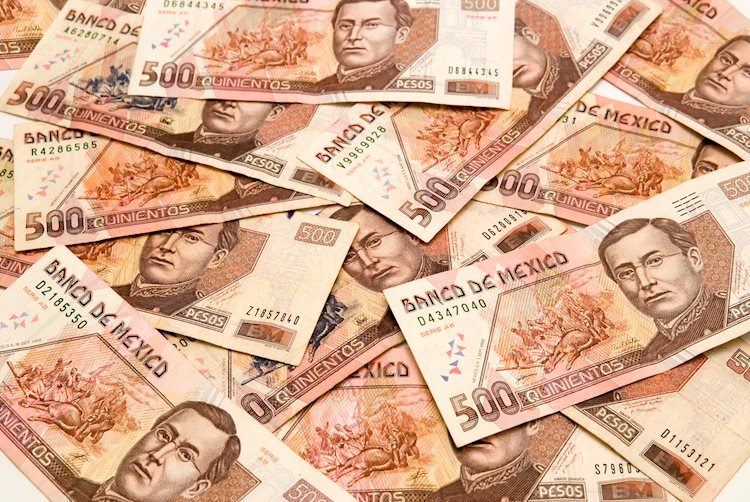- Mexican Peso finished the week on a lower note against the US Dollar.
- Mexico’s inflation rate will be the highlight of the economic agenda for the next week.
- USD/MXN could turn sideways after Banxico is determined to hold rates higher to curb inflation.
The Mexican Peso (MXN) held to its gains vs. the US Dollar (USD) on Friday after words from a Federal Reserve (Fed) official sparked a risk-off impulse, though the emerging market currency stood afloat. Nevertheless, it registered more than 1% weekly losses, as the USD/MXN closed trading at 17.42, with gains of 1.17%.
Before focusing on the words from the New York Fed President John C. Williams, the economic docket in Mexico would feature Business and Consumer Confidence, S&P Global Manufacturing PMI, and the Consumer Price Index (CPI), with all the data related to September. Aside from this, the New York Fed President Williams commented the US central bank had finished raising rates but stressed they should leave them high for “some time.” That weighed on US equities as Wall Street’s finished mixed, with the outlier being the Nasdaq 100, posting decent gains of 0.14%-
Adding to the sour sentiment was the news of an imminent US government shutdown, turning sentiment sour, with the US House of Representatives rejecting a bill to fund the government for 30 days, on a 232-198 split vote, against the bill approved by the US Senate. That said, most US economic data releases could be delayed if both sides, the Republicans and Democrats, did not reach an agreement.
Daily Digest Market Movers: Mexican Peso to remain pressured if risk aversion persists next week
- The Bank of Mexico (Banxico) held rates at 11.25% and revised its inflation projections from 3.5% to 3.87% for 2024, above the central bank’s 3% target (plus or minus 1%).
- Banxico’s Government Board highlighted Mexico’s economic resilience and the strong labor market as the main drivers to keep inflation at the current interest rate level.
- BBVA updated Mexico’s economic growth forecast, seeing the Gross Domestic Product rising to 3.2% from 2.4% in 2023 and 2.6% from 1.8% in 2024.
- Mexico posted an August $38,944.3 million pesos deficit.
- Mexico’s Unemployment Rate edged lower from 3.1% in July to 3.0% MoM in August, according to the National Statistics Agency (INEGI).
- September’s first-half inflation report in Mexico was 4.44%, down from 4.64% in August, according to INEGI.
- Being an emerging market currency, the Mexican Peso weakens amid risk aversion. Therefore, news emerging of a possible US Government shutdown triggered a flow toward safe-haven assets, weakening the Mexican Peso.
- The drop in Oil prices weighs on the Mexican currency, as its economy relies on crude exports.
- Moody’s rating agency warned the fiscal strategy of the Mexican government in 2024 must be credible after the June elections in defining the country’s stable outlook.
- In July, Moody’s lowered Mexico’s rating to “Baa2” with a “stable” outlook but warned of fiscal pressures for the next government due to the 2024 economic budget.
- USD/MXN extended its losses as US Core PCE fell from 4% to 3.9% YoY in August.
- Broad Greenback strength halted the USD/MXN drops as the US Dollar Index (DXY) reclaimed the 106.00 mark at around 20:00 GMT.
Technical Analysis: Mexican Peso
The Mexican Peso (MXN) found its foot after depreciating to 17.81 versus the US Dollar, near the 200-day Simple Moving Average (SMA) at 17.84. The USD/MXN is accelerating its downtrend after closing below 17.60, with sellers eyeing a push below the 20-day Simple Moving Average (SMA) at 17.32. If that level is lost, the USD/MXN pair would test the 100-day SMA at 17.18, followed by the 50-day SMA at 17.10. If the exotic pair remains above the September low of 16.99, it could resume the one-month upmove.
Risk sentiment FAQs
In the world of financial jargon the two widely used terms “risk-on” and “risk off” refer to the level of risk that investors are willing to stomach during the period referenced. In a “risk-on” market, investors are optimistic about the future and more willing to buy risky assets. In a “risk-off” market investors start to ‘play it safe’ because they are worried about the future, and therefore buy less risky assets that are more certain of bringing a return, even if it is relatively modest.
Typically, during periods of “risk-on”, stock markets will rise, most commodities – except Gold – will also gain in value, since they benefit from a positive growth outlook. The currencies of nations that are heavy commodity exporters strengthen because of increased demand, and Cryptocurrencies rise. In a “risk-off” market, Bonds go up – especially major government Bonds – Gold shines, and safe-haven currencies such as the Japanese Yen, Swiss Franc and US Dollar all benefit.
The Australian Dollar (AUD), the Canadian Dollar (CAD), the New Zealand Dollar (NZD) and minor FX like the Ruble (RUB) and the South African Rand (ZAR), all tend to rise in markets that are “risk-on”. This is because the economies of these currencies are heavily reliant on commodity exports for growth, and commodities tend to rise in price during risk-on periods. This is because investors foresee greater demand for raw materials in the future due to heightened economic activity.
The major currencies that tend to rise during periods of “risk-off” are the US Dollar (USD), the Japanese Yen (JPY) and the Swiss Franc (CHF). The US Dollar, because it is the world’s reserve currency, and because in times of crisis investors buy US government debt, which is seen as safe because the largest economy in the world is unlikely to default. The Yen, from increased demand for Japanese government bonds, because a high proportion are held by domestic investors who are unlikely to dump them – even in a crisis. The Swiss Franc, because strict Swiss banking laws offer investors enhanced capital protection.
